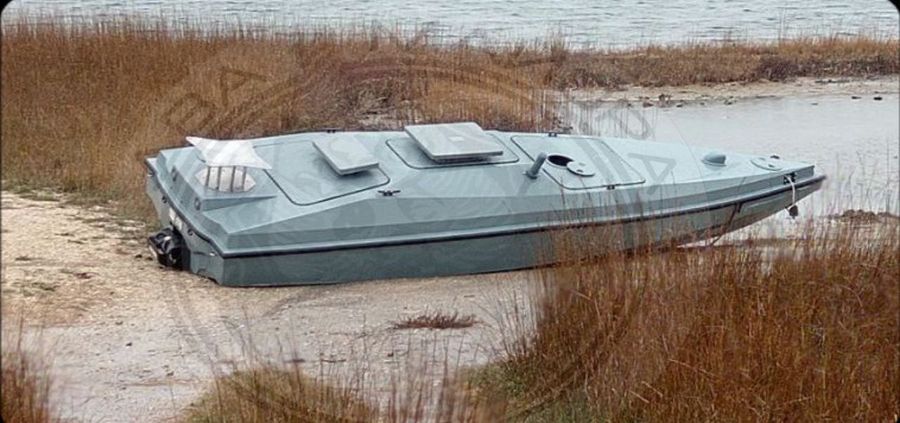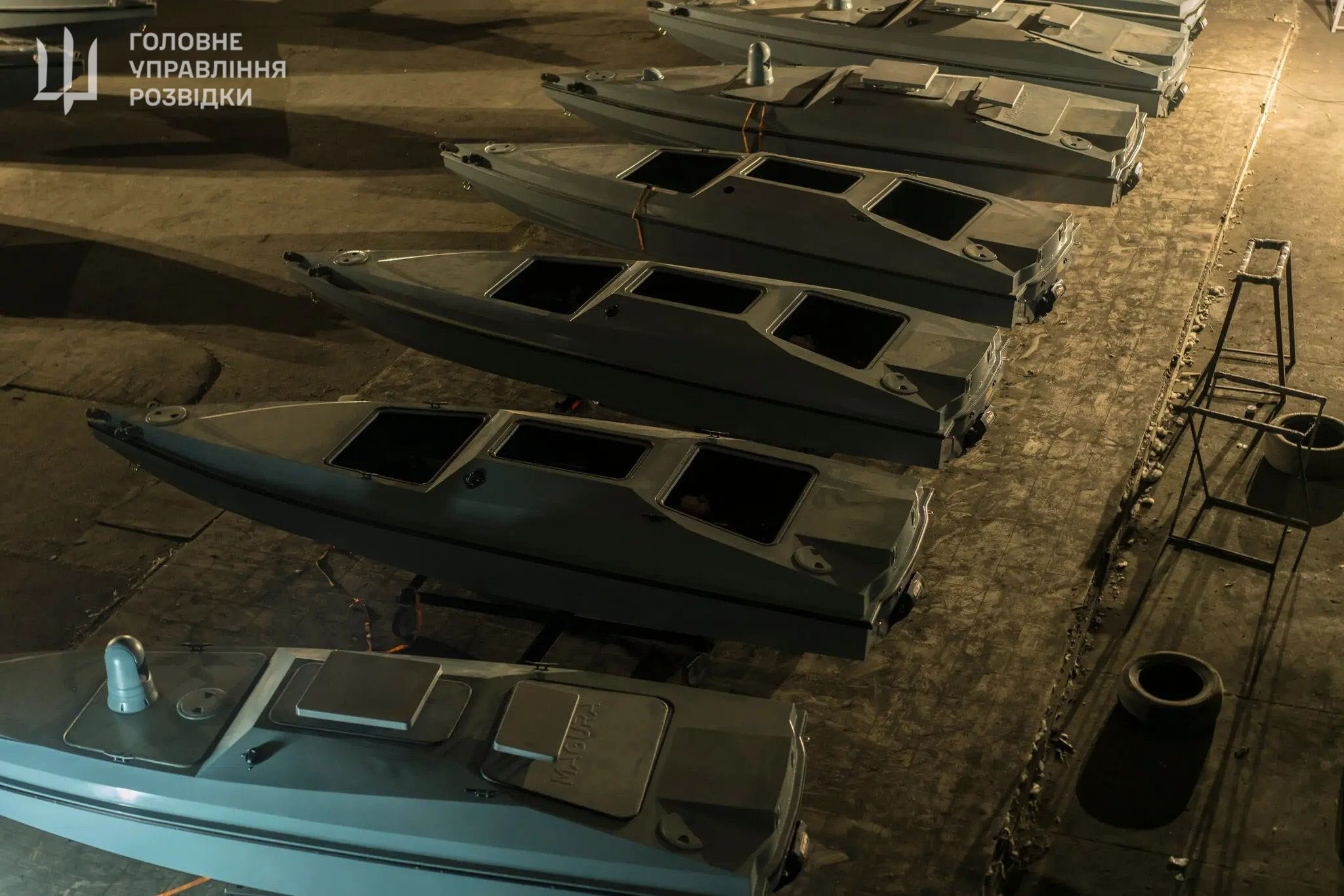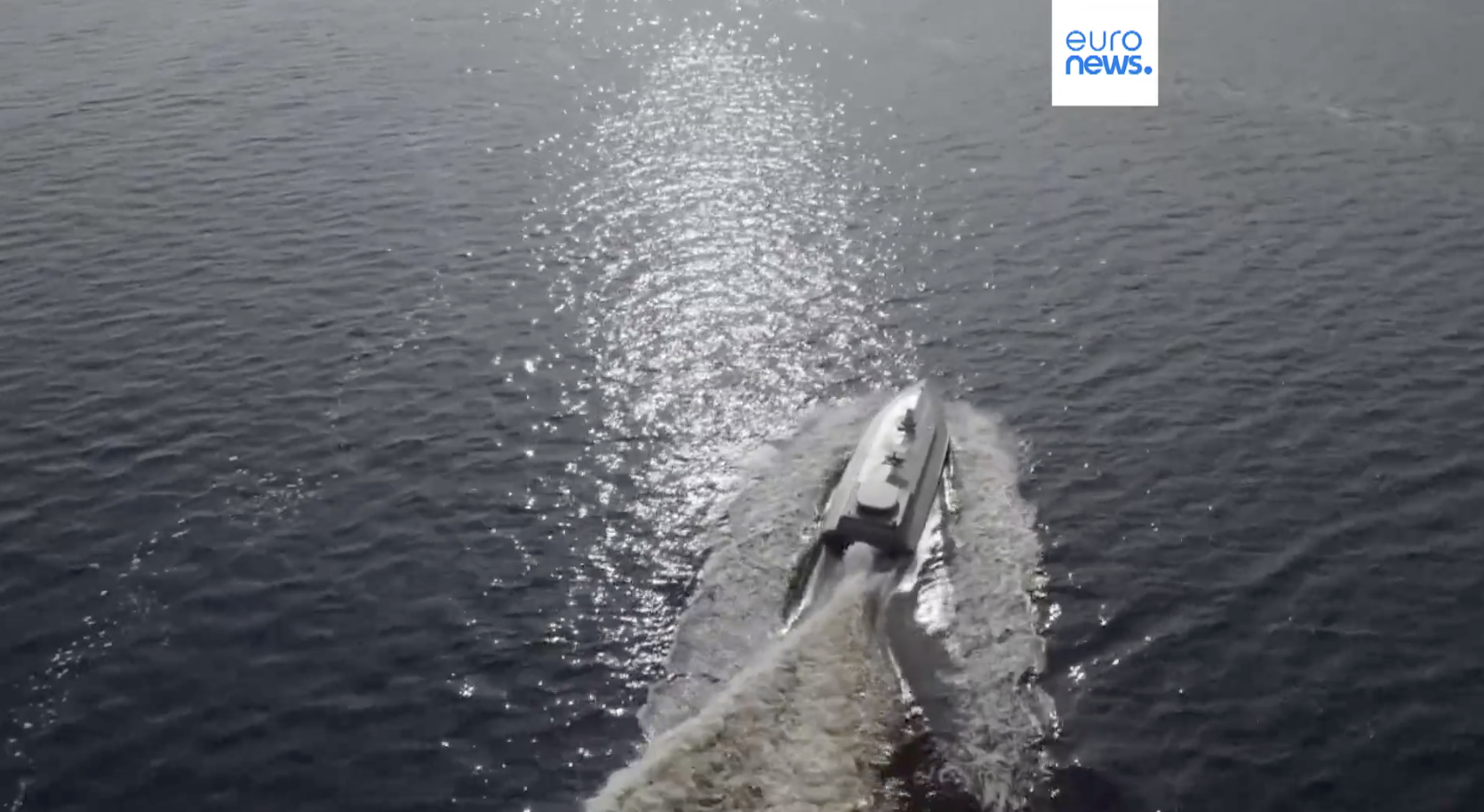Ukraine has developed innovative naval drone capabilities to reclaim the Black Sea from Russia's Black Sea Fleet domination. Ukrainian long-range strikes with surface suicide drones and cruise missiles have pushed Russian ships further away from the Ukrainian coast. Currently defenseless against Russian attack helicopters and ship armaments, maritime drones such as Magura V5 rely solely on maneuverability during suicide charges on Russian ships.
Soon, they may begin to hide and fight back: the Magura surface drones, which are behind the sinking of Russia's guided-missile corvette Ivanovets, the large landing ship Tsezar Kunikov, and the patrol corvette Sergei Kotov in February-March 2024, are expecting weapon upgrades.
The ongoing Russo-Ukrainian War has revolutionized the use of uncrewed surface vessels (USVs), with Ukraine leveraging new technologies for sea denial and Russia developing similar systems. Advances in semi-submerged and fully submerged drones, or UUVs/AUVs, offer advantages due to their smaller size compared to manned vessels. The Magura is a surface drone, the Ukrainian intelligence's working horse in the Black Sea.
Ukraine plans to upgrade its Magura V5 naval drones to address their current defenselessness against Russian gunship helicopters that often hit them during drone suicide missions against Russia's navy, according to Ukraine's military intelligence chief: work is underway to improve the Magura to add capabilities of engaging ground, surface, and air targets.

In his interview with Ukrainska Pravda, Kyrylo Budanov, the chief of Ukraine's Main Directorate of Intelligence (HUR), said:
"Specialists are currently working on installing air defense equipment on the [Magura V5] unmanned platform. I'm not a technician, but I understand that this is a rather difficult task. We need means of detecting a target, capturing an air object, and a means of destruction - and all of this must be placed on a fairly small platform. This is not an easy task from a purely technical point of view, but it is real [to achieve]," Budanov told UP.
A Magura developer told Ukrainska Pravda that wave impacts and pressure drops strain the drone's structure, making stabilizer development a significant challenge. However, work is already in progress to equip the drones with modules for targeting ground, surface, and air targets. Efforts are also being made to enhance their stealth, including the ability to dive underwater temporarily.
Ukraine has been actively developing and using various naval drones, with Russia later joining the arms race but has yet to showcase its designs in action.

Ukrainian maritime drones have made Russia's Black Sea Fleet vulnerable, forcing it to move the fleet's core from occupied Crimea to Russia's Novorossiysk on the Black Sea's eastern coast, yet still within Ukrainian drone range. Russian ships now avoid the Ukrainian coast and reduce open sea time, with Kalibr missile launches from the Black Sea decreasing significantly, says Ukrainian Navy spokesperson Dmytro Pletenchuk, BBC says.
In late 2023, the HUR noted that Ukraine successfully used marine strike drones to clear a sea strip of up to 200 miles from the coast, creating a safe shipping corridor free from Russian presence.
The story of Magura
In the summer of 2022, a few months into Russia's full-scale invasion, the concept of uncrewed surface vessels (USV) existed only as theoretical designs on a drawing board, according to Ukrainska Pravda. But the Ukrainians were highly motivated to explore any avenues to target Russia's Black Sea Fleet after the sinking of Russia's flagship, the Moskva missile cruiser, with two indigenous Neptune missiles.

The lethal Magura drone program could have never made it into the hands of the HUR intelligence agency. Initially, the manufacturer of this had plans to work with Ukraine's Security Service (SBU) on developing their naval drones instead.
By September 2022, the first relatively primitive prototypes of the Magura drone were completed - little more than simple unmanned surface vessels with basic engines, Starlink satellite communications, and control systems.
On the night of 16-17 September 2022, the bare-bones Magura drones were launched into Sevastopol Bay in their first combat deployment, though this attack failed due to Starlink being blocked near the Russian-occupied peninsula.
Elon Musk indeed thwarted Ukrainian attack on Crimea by blocking Starlink
— Euromaidan Press (@EuromaidanPress) January 3, 2024
Musk earlier claimed he never activated Starlink in Crimea to begin with. However, witnesses say he deliberately switched it off during Ukraine's first major attack on Crimeahttps://t.co/WMU5GX1asd
The Ukrainians persisted, and just over a month later, on 28-29 October, their naval drones managed to breach through Sevastopol's layered defenses. Though the full damage was initially unclear, it later emerged they reportedly damaged the radar on the Russian Black Sea Fleet's new flagship, the Admiral Makarov frigate.

Disputes over quality control, budget, and design specifications between the SBU and the drone developer disrupted the program in 2022, leading the SBU to sever ties and start an independent naval drone project that later resulted in Sea Baby USV.
Ukraine unveils Sea Baby Avdiivka naval drone
The ousted company then partnered with Ukraine's Defence Intelligence Directorate, which was conducting its own clandestine unmanned maritime operations, and accelerated the Magura's improvement.
The USV would become one of Ukraine's most potent weapons in denying Moscow the naval supremacy it required to bombard cities and make amphibious landing attempts.
The Magura drones can carry an explosive payload of 320 kg and sail up to 800 km on one-way missions.
Magura's first HUR mission
The initial Magura prototypes had relied heavily on SpaceX's Starlink satellite internet network for command and control, which had already proven to be a glaring vulnerability with the service being restricted in Russian-occupied zones. For the HUR's upgraded Magura models, the developers implemented backup communications channels and other redundancies to ensure resiliency if any single uplink was disrupted or jammed.
Their concept evolved into a "drone of drones" strategy, with a single operator managing coordinated teams of autonomous, networked Maguras that could share sensor data and adapt if one drone's communication was disrupted. "Borets," head of the HUR's unmanned systems department, described an operation where they lost connection as they approached a ship. Despite the initial loss of control and the ship's crew repelling the attack, the connection was restored, and they pursued the ship for six hours until it ran out of ammunition. Some drones ran out of fuel, and others were damaged, but they successfully reached their target.
Their first significant success came in May 2023 when, despite challenges like interference and jamming, the Magura struck the Russian spy ship Ivan Khurs over 500 km away at sea. This moment showcased the Magura's resilience and marked the HUR's emergence in maritime operations after extensive trials with simpler naval drones. The attack on the Ivan Khurs highlighted advancements in sensor capabilities, onboard optics, and coordination among the Magura drones.
https://twitter.com/EuromaidanPress/status/1661733100018360320
The ultimate vision was taking shape - a networked "Wolf Pack" of unmanned agents designed to isolate, obstruct, and destroy Russian naval forces, enhancing Kyiv's ability to disrupt Moscow's naval strategies. The control setup for these drones is minimal, with just two computers, a control panel, and an ergonomic chair for the operator's comfort during long missions. This setup enables marathon operations, allowing Ukraine to project power across the Black Sea.
Trending Now
The first sunken ships
The summer of 2023 saw sporadic successes for the HUR's naval drones, damaging Russian patrol ships like the Sergey Kotov and Vasily Bykov. They were gradually targeting larger ships, testing their defenses and electronic warfare systems.
By November, the Magura drones achieved their primary goal: sinking Russian ships in maritime ambushes. On 10 November, near Crimea's Chornomorske, a wolfpack of Maguras tracked and struck a Russian naval convoy. The first wave focused on crippling the engines and mobility of the targeted landing craft of the Serna and Akula classes.
Ukraine hit two Russian small landing craft with naval drones
"The main goal of the first phase is to immobilize the target, so the first strike is usually to the engines," a Magura developer explained the multistage tactics to Ukrainska Pravda. "In the second phase, the most vulnerable part is hit - if a hole is blown, additional drones are driven into it and detonated."
With the convoy halted and damaged, the final Maguras delivered the coup de grace below the ships' waterlines, sinking them in a historic double-sinking.
According to the HUR's report at the time, reconnaissance in Crimea's Uzkaya Bay revealed that surface strike drones destroyed two Russian Black Sea Fleet's small landing ships - an older Akula (project 1176) and a newer Serna (project 11770). Both Russian vessels sank, with the Akula going down immediately and the Serna struggling before succumbing.

The Magura's first demonstration of its anti-ship capacity stunned observers, as Ukrainian operators overwhelmed Russia's Black Sea Fleet defenses from afar, raising questions about the potential havoc Maguras could wreak elsewhere.
The answer came in winter strikes, with Magura swarms sinking the Ivanovets on 1 February 2024, and the Tsezar Kunikov on 14 February. The attack showcased a new era in naval warfare, with Ukrainian operators controlling the drones from Kyiv, over a thousand kilometers away.
Ukrainian naval drones sink large Russian landing ship Caesar Kunikov
As the Kunikov's crew panicked and tried to evade the drones, they were unaware that their attackers were comfortably situated in an office in the capital. The Kunikov, not initially the primary target, became the focus as the situation evolved, with operators swiftly redirecting the drones to swarm and overwhelm the unprepared ship.
In less than a year, the Magura suicide drones have permanently removed four Russian warships—Serna, Akula, Ivanovets, and the prestigious Tsezar Kunikov—from Moscow's fleet. These naval assets, which once intimidated merchant ships and disrupted Ukrainian maritime commerce, are now being hunted to extinction by Kyiv without risking a single human life at sea.
In the carefully phrased words of one Magura engineer:
"You see, the technology is developing, and the operators' skills are growing. I'd like to think that it's solely a matter of our technological and experiential superiority, but in reality the training of our target ships' crews, or lack thereof, also plays a role," a developer told Ukrainska Pravda
BBC says it talked to the secret Ukrainian military intelligence unit Group-13, created last year, and the unit says they have sunk five Russian ships and damaged several others. Their commander, who asked to be referred to by the call sign "Thirteen," mentioned that Sergey Kotov was the most challenging target, which was successfully sunk only on the third attempt after two attacks.
The Russians have clearly recognized the severe threat the Maguras pose as well. In a likely attempt to cripple Ukraine's production pipeline, Moscow launched a retaliatory Iskander ballistic missile strike on one of the known Magura manufacturing facilities.
Looking ahead
As international rules for unmanned maritime warfare are still being defined, the Black Sea's subsurface arms race is escalating in lethality. Both sides are planning significant upgrades for the next generation of naval drones. For the Magura series, there are plans to integrate comprehensive air defense capabilities to protect drone swarms from aerial threats. Anti-air self-protection, previously a lower priority for models focused on anti-surface warfare, has become crucial for survivability due to evolving Russian countermeasures and UAV-hunting tactics.
Future Magura variants aim to be "anti-everything" drones, armed with heavyweight anti-air missiles to not only attack enemy ships but also establish local air superiority and support amphibious assaults. Additionally, there are plans to enhance stealth capabilities, making the drones harder to detect by Russian sensors.

This could involve reducing radar cross-sections, minimizing infrared and electromagnetic signatures, or even brief submersion to bypass shoreline defenses. Borets notes that such advanced vehicles were unprecedented before the full-scale war in Ukraine, and future drones will become increasingly less noticeable, even capable of underwater diving.
The aim is to perfect the Magura's role as a formidable "shipkiller of shipkillers," with Intelligence Chief Budanov and the engineers acknowledging the potential for improvement. Budanov emphasizes that naval drones alone cannot reclaim Crimea without boots on the ground, but they can hasten the withdrawal of the Russian Black Sea Fleet from the region.
Inter-agency arms race
Russia's Black Sea Force is pressured to quickly recover losses and develop countermeasures to defeat drone wolfpacks, likely exploring all protective measures regardless of cost, and also developing its own naval "kamikaze" drones. Meanwhile, Ukraine is also advancing various maritime drone programs.
The Security Service of Ukraine (SBU) has developed the multi-purpose Sea Baby naval drone platform for mine deployment, coastal target strikes, and novel payloads like flamethrowers. They also share control with the Navy of the Mamai long-range strike drone for precise hits on targets in Russia proper, like Novorossiysk, albeit with smaller warheads.
Russia's Novorossiysk Bay and Crimea's Sevastopol are strategic targets with strong defenses, but overcoming them is feasible, Budanov noted to Ukrainska Pravda, but it's more efficient to intercept ships on duty or during repositioning than to breach harbor defenses.
https://twitter.com/EuromaidanPress/status/1687399897484455936
Ukraine's drone forces are collaborating on maritime missions, with each unit playing distinct roles. In the Novorossiysk attacks, the HUR's Magura drones, the SBU's Sea Baby and Mamai systems were involved, with the SBU leading and Mamais hitting and damaging the large landing ship Olenegorsky Gornyak and the Sig tanker in August 2023. However, despite their participation, the HUR's Maguras were not mentioned in the official summaries, indicating a competitive dynamic between the agencies.
New Ukrainian surface drone joins fight in Black Sea
From humble beginnings, Ukraine has rapidly advanced its naval drone technology in just two years, achieving results and imposing costs that were once deemed improbable. If the arms race continues to escalate, the next phase in nautical warfare could revolutionize centuries of maritime tradition.

